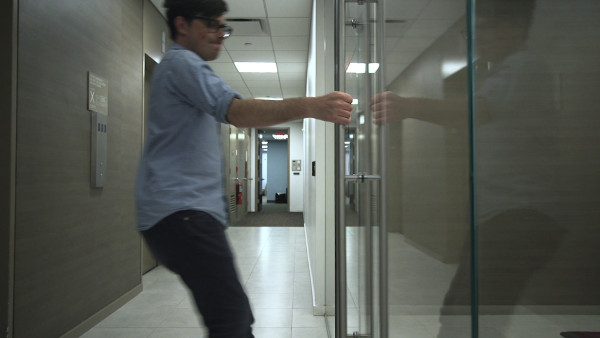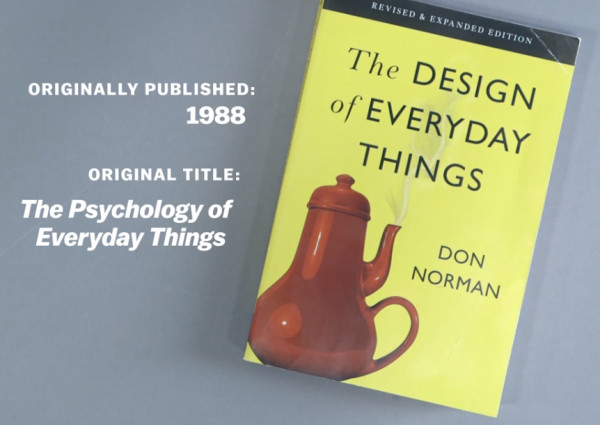Some doors require printed instructions to operate, while others are so poorly designed that they lead people to do the exact opposite of what they need to in order to open them. Their shapes or details may suggest that pushing should work, when in fact pulling is required (or the other way around). Roman Mars teamed up with Joe Posner of Vox to interview Don Norman and bring you this story of terrible doors:
A so-called “Norman Door” has design elements that give you the wrong usability signals to the point that special signage is needed to clarify how they work. Without signs, a user is left guessing about whether to push or pull, creating needless frustration.

There is no reason for these backward designs to persist, since various working solutions to the problem already exist, and yet these horrible doors are still all around us in the built environment.

This peculiar design problem is part of what motivated Don Norman (hence: Norman Door) to write his now-classic book The Design of Everyday Things. Similar issues can be found in other everyday objects as well, from light switches and sink handles, which frequently feature counter-intuitive functions or modes of operation.
An advocate of user-centric (or: people-oriented) design, Norman offers insights that bring together aspects of usability, engineering, and cognitive science. His book provides an enlightening look into the intersection of these disciplines and design, informative and educational for users and designers alike.



Comments (26)
Share
It made me so happy that you did this topic! I love Norman’s book. One correction though – the original title was actually ‘The Psychopathology of Everyday Things’ (Wikipedia has it wrong too). Norman says somewhere that designers prefer the new title but psychologists like the original play on Freud.
Hi Sandra,
In the preface in “The Design of Everyday Things,” Norman refers to it multiple times as “The Psychology of Everyday Things.”
Thank you!
With all the brilliant design out there, it’s frustrating to see such a common, simple object like a door designed wrong.
My previous office (custom spec’d by the marketing agency that occupied the space) had those same glass doors that the Vox office has. Two years in that office and I still never got them right. Also one employee busted her nose walking into one thinking it was open. Amazing how one door can have so many design flaws.
I spent four of the most frustrating/embarrassing minutes of my middle-aged life trying to get into the fan shop for FC Sparta in Prague in May 2015. My colleague and I arrived just as the shop was opening. We walked up to the front door with confidence, barely a sentence of Czech between us. The door was locked. The side doors were locked. The shop was empty, except for a cashier who seemed not to notice us. Knocking on the door won her attention, but she merely nodded and raised her eyebrows. The signal: permission to enter. We tugged again. Nothing. She seemed to lose interest in us and went back to folding Sparta kits on the counter.
We conferred, trying to figure out this unexpected test of shopping etiquette. Our only adjustment was to tug harder, sure that we were somehow not pulling correctly. She looked at us again and made some indecipherable hand signal. We tugged. The pressure was mounting; a tour bus had pulled up and would soon unleash its throng. Oh, how we pulled on that door. We walked away to survey from a short distance. The bus was hissing.
I don’t know how it happened—I’m sure it wasn’t intentional—but the slightest of nudges forward, and we were in the shop. The cashier rolled her eyes in the most spectacular display of tourist fatigue that I saw in those two weeks. Needless to say, our Ph.D.s didn’t help us at all in this fight with a door that had a pull handle but needed to be pushed. A small child could probably have used just his/her pinkies to push that door open.
http://comenius.susqu.edu/hist/112/slavishak/sparta.jpg
Rule of thumb: If you can’t see the hinges, it’s most likely “push” to open.
Great video. But why would Norman name the poorly designed doors after himself? Seems like he’s accepting blame for something he didn’t do.
I’m taking the Norman Door name more as “the door Norman would have used”, because if it would have happened to anyone, it would have happened to Norman.
THANK YOU, THANK YOU, THANK YOU, THANK YOU, THANK YOU!!!
(sorry for shouting)
As a designer, I walk through the world allowing things like Norman doors to bother me more than they probably should. More than once have I found myself in the middle of a “if you’re suppose to push, there should be a plate, if you’re suppose to pull, there should be a handle” tirade only to look up to see the perplexed faces of my companions who can’t figure out why it matters so much to me. Design should make your life easier, not more confusing. Function should always trump form. The sure sign of a hackneyed designer is someone who chose their elements because they “looked cool” (like the door handle in the video). It doesn’t matter if it looks cool if it makes the product a pain in the ass to use. AAAAGH! The sign of a truly great designer is one who can create function wrapped in a beautiful form.
I also advise that you not dine out with me unless you want to get into a deep discussion about why the menu design sucks. Maybe you guys could do a podcast about that!
Sounds ok to me. I always critique menu designs and sometimes even complain to the manager if it’s really bad. When I explain to them how impacts their bottom line they suddenly begin to pay attention.
So love the tirade, just so you know if you have a door that has a pull handle on it and a label that says “push” you will always pull as you brain process visual signals way faster than it can read language and convert, so any sign on the door using language is going to be an instant fail….
Try reading the sign on the door before you get to the door.
Don’t text while walking!
Many doors of this kind will swing either way.
Many also have a push plate mounted on the handle.
I think the only way around the tyranny of bad doors is to look for the hinges. It could be a good lifehack :D
I think the only way around the tyranny of bad doors (although not ideal) is to look for the hinges. It could be a good lifehack :D
Apple’s iPhone alarm experience is the digital equivalent to Norman doors.
There is a reason for everything. I am sure the reason for these doors is that they can all be manufactured one way and put on whatever entryway in whatever position needed. Sometimes cost and manufacturing trump usability.
No. Sometimes there are no experts in charge. Sorry.
Nah, when my office renovated, they put in glass doors with vertical handles on both sides on the front doors instead of the vertical+horizontal bars elsewhere in the building. It was done that way totally for The Aesthetic™.
Now how about I point out how many lavatory sinks require you to stoop over and strain your back to wash your hands.
All the short people in the world sincerely apologize to you for our existence.
Remember that you were once a short person for a while.
On commercial multiple occupancy spaces fire codes require doors leading out to swing outward. If a double door, one must swing outward. If one swings inward, it should be on the right side of the pair.
Perhaps this may give you a hint as to which way a door swings.
Mechanical things should be designed so that they can be assembled only in the correct way. Some are designed not only so that they will go together in the wrong way but will run. In the wrong way. Bad.
The Ford Model T comes to mind: The axle would go on even if flipped. The car would then back up when the control pedals were operated for the car to go forward.
The early automatic transmission selectors were P-N-D-S-L-R or P-N-D-2-1-R. If the selector was pulled to what appeared or felt to be “R” but was actually in Low or 1, the car would go forward. Bad.
It seemed to be that the person typically confused by this was the “little old lady.” She would think she was backing out of a parking space. Step on the gas and the car would strain against the curb. Step on the go pedal harder and the car would suddenly lunge over the curb and into or through the store wall.
Selectors were changed to the universal P-R-N-D-S-L or P-R-N-D-2-1. Problem fixed! on later car production.
Typical entitled American cannot fathom that other cultures do things differently than him and writes a (self-loving) book about it. Great! What authority.
Unfortunate and BAD that Joe Posner, who made the otherwise great video, chose to portray the two dumb crooks with black actors.
As it says in the bottom left it’s a clip from the film Snatch
The absolute worst designs exposed to occasional users are bath fixtures. I have spent up to 20 minutes trying to get the water the right temperature and flowing out of the correct faucet.
I majored in Human Factors Engineering three decades ago and I love this kind of topic. The video was interesting but I will not be sharing it, because of the gratuitous negative portrayal of Black people in the closing scene. It’s highly offensive. Please edit it out.